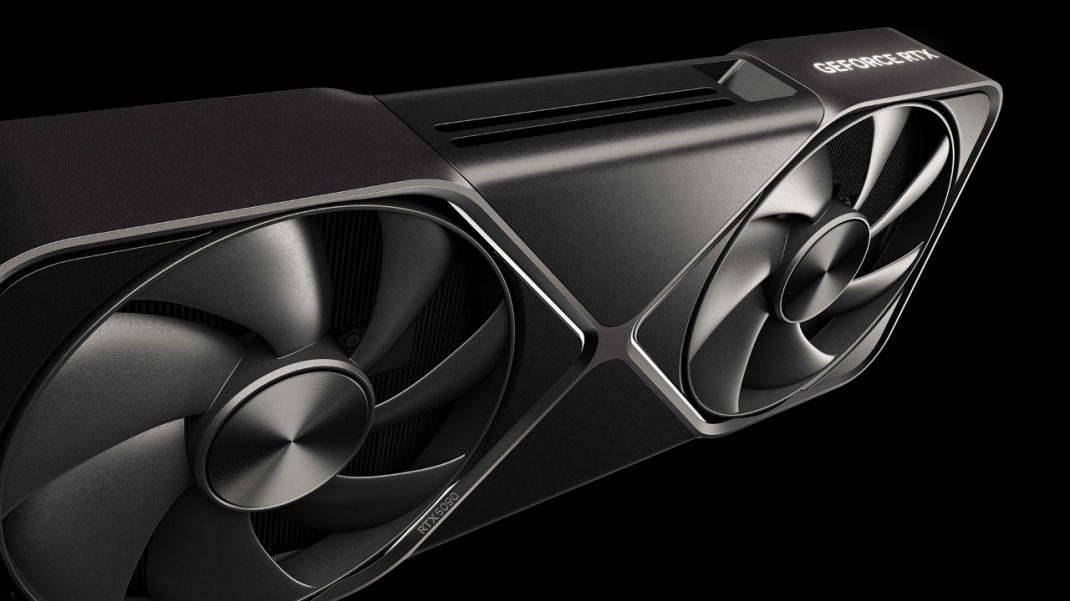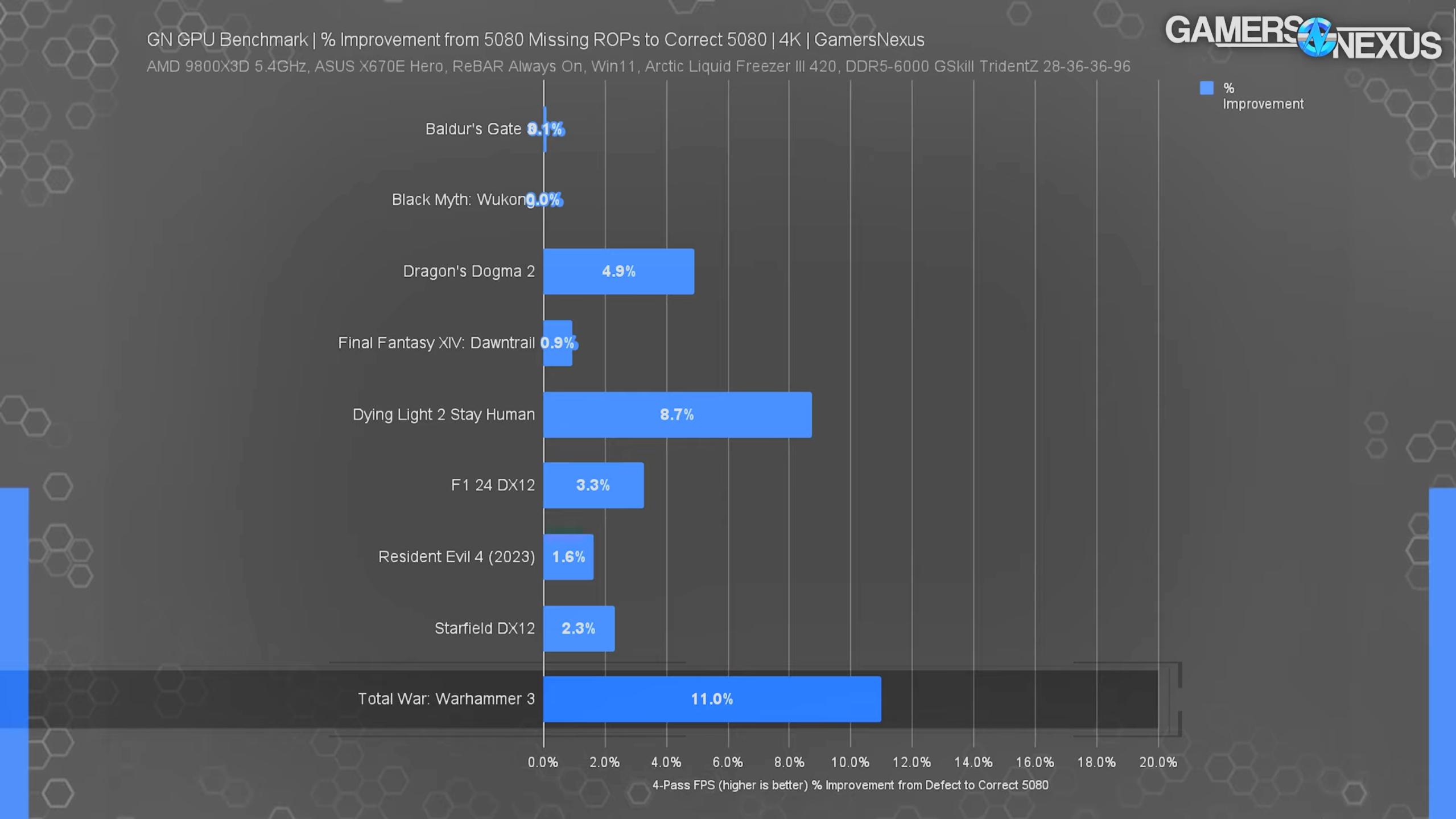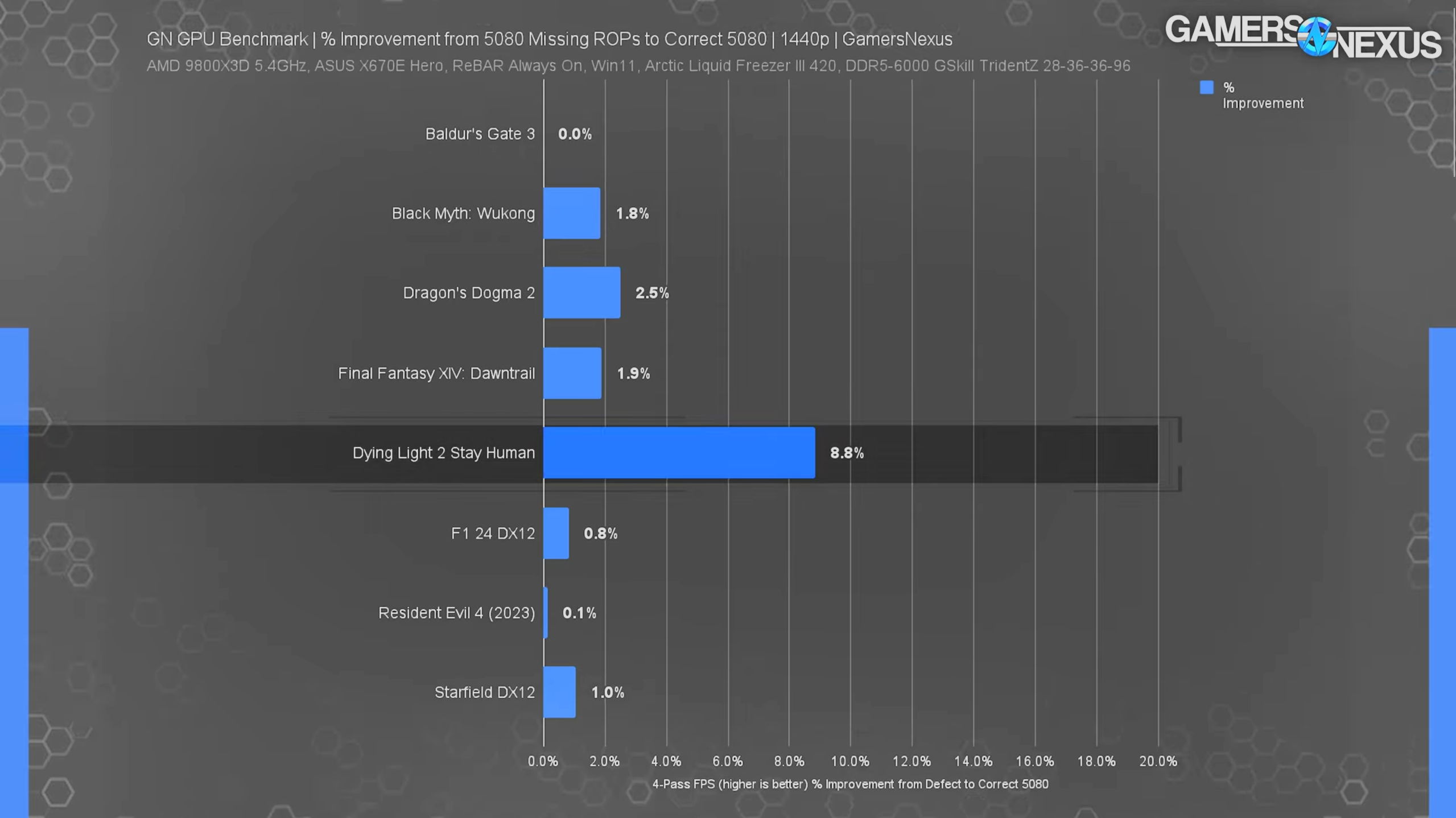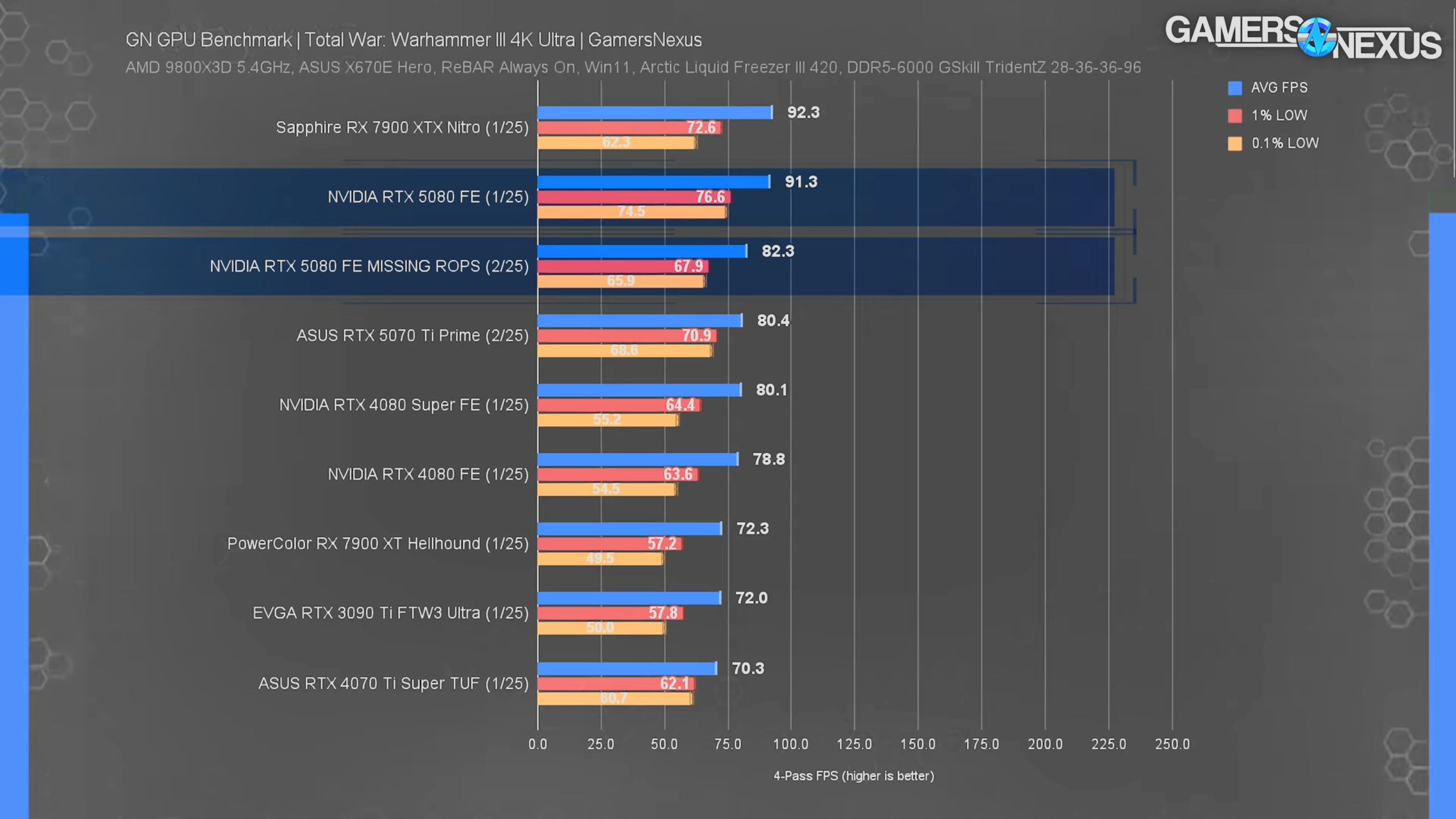Defective RTX 5080 takes up to 11% performance hit in gaming — Larger impact at higher resolutions
Brings it down to RTX 5070 Ti levels in some scenarios.

We finally have some reputable data about the expected performance penalty for Nvidia's defective RTX 50 series GPUs, thanks to Gamers Nexus. The YouTube channel's Steve Burke put up a bounty for Blackwell cards with missing ROPs. Burke offered a $500 bonus on top of the price on the receipt while covering both shipping and taxes. He successfully managed to procure a defective RTX 5080 Founders Edition in exchange for a Zotac equivalent with all its ROPs operational.
In its original statement, Nvidia confirmed that only 0.5% of produced RTX 5090s and RTX 5070 Tis had been affected by the missing ROPs issue. This assertion would be short-lived, as just two days later, we found an RTX 5080 with a similar defect; it had 104 ROPs instead of the advertised 112. In synthetics, based on user-testing, the nerfed RTX 5080 scored 12% lower than what you'd normally expect. TechPowerUp's results were the only estimate of the performance delta in gaming benchmarks before these Gamers Nexus tests. The RTX 5070 should not be subject to similar problems. Even if defective chips were produced, let's hope AIBs and Nvidia can manage to keep them out of consumer hands.
Nvidia reported an on-average 4% difference in graphical performance if a GPU had missing ROPs. In the handful of games Burke tested, simple bad luck could land you up-to 11% behind other RTX 5080 users, as shown in Total War: Warhammer 3 at 4K. Moving over to the 1440p results, the gap closes somewhat as most games are within 3-4%, with a maximum variation of 8.8% in Dying Light 2 Stay Human. The data indicates that higher resolutions are generally more taxing on the ROP units.
When compared against other GPUs in the same ballpark, in the worst-case scenario, the defective RTX 5080 falls to RTX 5070 Ti levels, which invalidates the $250 price gap between the two. Of course, these results are game-dependent, so these outcomes aren't universal.
The best resolution from Nvidia is to create a driver-level identifier to alarm users if their RTX 50 GPU is missing ROP units. This is because the average consumer likely doesn't use third-party hardware monitoring utilities like GPU-Z and HWiNFO. Even if partners are offering replacements and refunds, supply constraints could keep you waiting for days, if not weeks for a new graphics card.
On the bright side, faulty RTX 5080s, before PCB assembly, could be repurposed by Nvidia (through software) as RTX 5070 Tis, in the future. A BIOS reflash could potentially restore these special units to RTX 5080 specs, unless Nvidia scraps these dies.
Get Tom's Hardware's best news and in-depth reviews, straight to your inbox.

Hassam Nasir is a die-hard hardware enthusiast with years of experience as a tech editor and writer, focusing on detailed CPU comparisons and general hardware news. When he’s not working, you’ll find him bending tubes for his ever-evolving custom water-loop gaming rig or benchmarking the latest CPUs and GPUs just for fun.
-
jeremyj_83 Since this seems to have happened across all released RTX 5000 cards, I don't think this is some "mistake" by nVidia. I think they knew that these were defective and figured no one would recognize the slightly lower performance. Basically they didn't want to bin an almost perfectly good 5090 as a 5080 and decided to roll the dice that people wouldn't notice.Reply -
Gururu I can only imagine how many other chips from nVidia are affected by similarly covered up anomalies. I doubt this is nVidia's direct fault but something at TSMC QA.Reply -
ezst036 Reply
That's because Nvidia isn't a gaming company anymore.jeremyj_83 said:Since this seems to have happened across all released RTX 5000 cards, I don't think this is some "mistake" by nVidia. I think they knew that these were defective and figured no one would recognize the slightly lower performance. Basically they didn't want to bin an almost perfectly good 5090 as a 5080 and decided to roll the dice that people wouldn't notice.
Nvidia is an AI company whose cards are also, conveniently enough as an aside, really good for gaming. Nvidia 10+ years ago would not have put such carelessness to its gaming line. Guarantee they aren't doing this for their accelerators. -
ohio_buckeye Sounds like nvidia should be doing some refunds. At the very least rma. Could you imagine paying 1k+ for a card fyi to realize that your card performed like a card a step down?Reply -
Heat_Fan89 All I can say is that Jensen better not lose his rock-star status because this is going to catch up with Nvidia in a really bad way.Reply -
Heat_Fan89 Reply
Imagine paying $6K for an Alienware with an Ultra9 and that happened to the CPU as well because of crappy cooling. :unsure:ohio_buckeye said:Sounds like nvidia should be doing some refunds. At the very least rma. Could you imagine paying 1k+ for a card fyi to realize that your card performed like a card a step down? -
Mindstab Thrull Am I the only one who started reading that article in Steve's voice?Reply
Thanks, Steve. -
Giroro "Nvidia confirmed* that only 0.5% of produced RTX 5090s and RTX 5070 Tis had been affected"Reply
*CLAIMED
Come on guys, don't just take the word of a company's marketing spin team at face value. Nothing is confirmed until it's independently verified. Be journalists.
And worth pointing out again, either Nvidia detected and counted every single bad card they deliberately choose to send out, or they were not detecting the flaws and have absolutely no idea how many they sent out.
But the odds of them being able to know the faulty hardware was "pretty close" without knowing exactly what it was is essentially zero.
More likely they made a design change after they started shipping chips, and did not bother recalling the early units.
But Nvidia is an AI company and a crypto mining company second. They don't want gamers as customers, and they haven't pretended to care in like 6 years. -
Pierce2623 Reply
The cards are good for AI because that’s what Nvidia pushed for. A totally gaming focused GPU wouldn’t have tensor cores taking up near the die space they do. DLSS upscaling could do the AI on the shaders or like 15-20% the current number of Tensor cores. Frame gen is worthless garbage.ezst036 said:That's because Nvidia isn't a gaming company anymore.
Nvidia is an AI company whose cards are also, conveniently enough as an aside, really good for gaming. Nvidia 10+ years ago would not have put such carelessness to its gaming line. Guarantee they aren't doing this for their accelerators.



